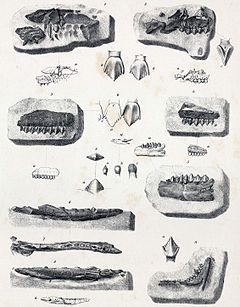


Samuel Husbands Beckles (12 April 1814, in Barbados – 4 September 1890, in Hastings) was a Bajan/English 19th-century lawyer, turned dinosaur hunter, who collected remains in Sussex and the Isle of Wight. In 1854 he described bird-like trackways that he thought could have been made by dinosaurs, which he later identified as probably those of Iguanodon in 1862.[1][2] In 1857, following the discovery of a mammal jaw at Durlston Bay, he directed a major excavation that became known as 'Beckles' Pit', removing five metres of overburden over a 600 square metre area, one of the largest ever scientific excavations. The collection of mammal fossils that resulted is now mainly held at the Natural History Museum.[3] He discovered the small herbivorous dinosaur Echinodon. The only known species Echinodon becklesii, the mammal Plagiaulax becklesii and the dinosaur Becklespinax were named in his honour (although the last of these is now known as Altispinax).
- ^ Beckles, Samuel H. (1854). "On the ornithoidichnites of the Wealden". Quarterly Journal of the Geological Society of London. 10 (1–2): 456–464. doi:10.1144/GSL.JGS.1854.010.01-02.52. S2CID 197536154.
- ^ Beckles S.H. (1862). "On some Natural Casts of Reptilian Footprints in the Wealden Beds of the Isle of Wight and of Swanage". Quarterly Journal of the Geological Society. 18 (1–2): 443–447. doi:10.1144/GSL.JGS.1862.018.01-02.60. S2CID 129210586.
- ^ "Purbeck: The Mammal Beds". Jurassic Coast Partnership. Retrieved 12 April 2015.